Tesco's Indian Market Entry: Opportunities and Challenges Case Study
VerifiedAdded on 2020/01/07
|8
|2280
|569
Case Study
AI Summary
This case study examines the justification for Tesco's expansion into the Indian retail market. It begins with an introduction to the growing retail industry and highlights the allure of emerging markets like India. The study analyzes the opportunities presented by India's developing economy and the growth potential of the retail sector, including market opportunities like the growth of organized retail and the changing consumer behavior. It then delves into the challenges Tesco faces, such as competition from the unorganized retail sector, cultural differences, and logistical hurdles. A PEST analysis is used to summarize the external factors affecting Tesco's operations, followed by a discussion of market entry strategies, specifically the joint venture with the Tata Group. The conclusion emphasizes the need for Tesco to understand the Indian market, adapt its strategies, and focus on value creation to achieve sustainable success. The study references various sources to support its findings.
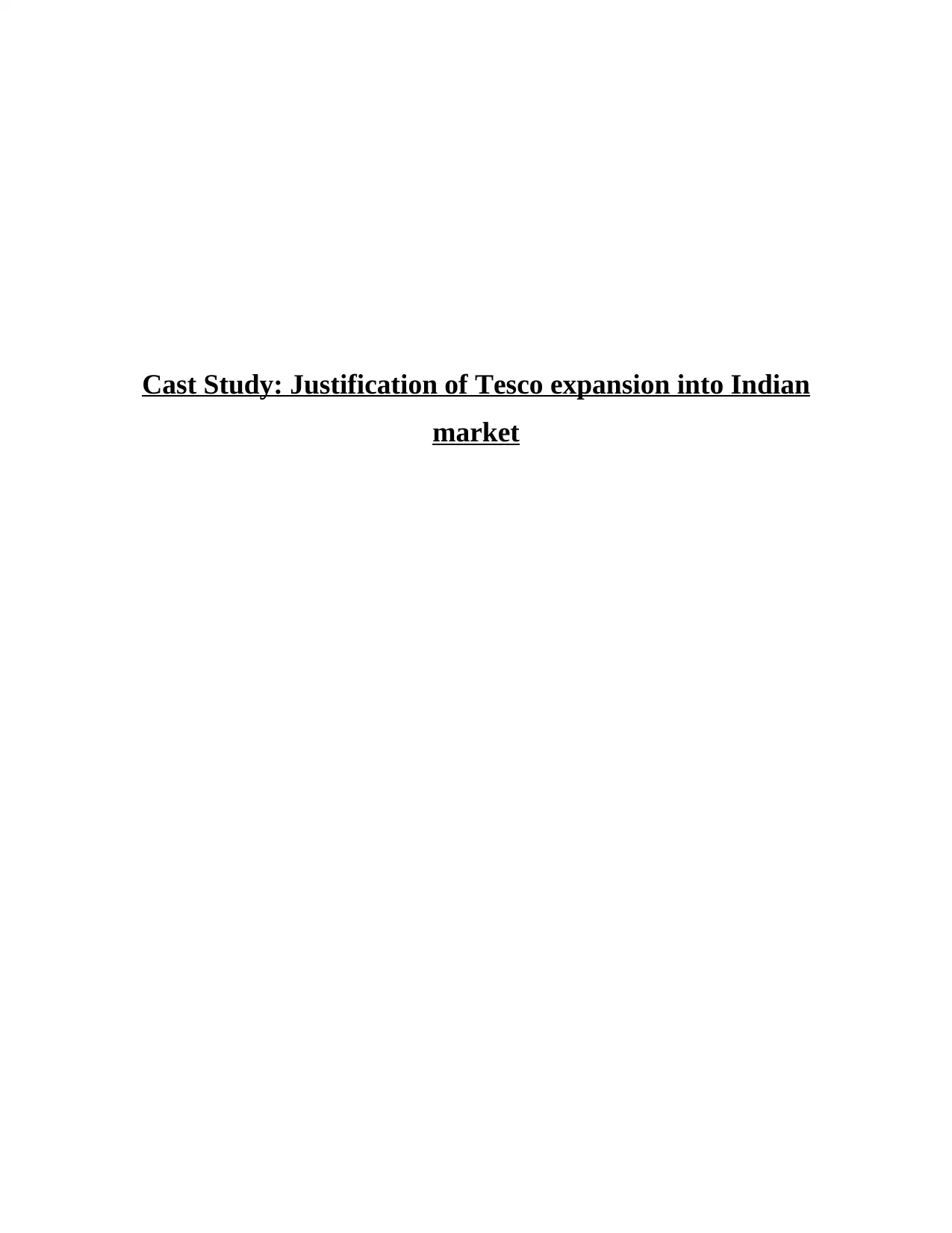
Cast Study: Justification of Tesco expansion into Indian
market
market
Paraphrase This Document
Need a fresh take? Get an instant paraphrase of this document with our AI Paraphraser
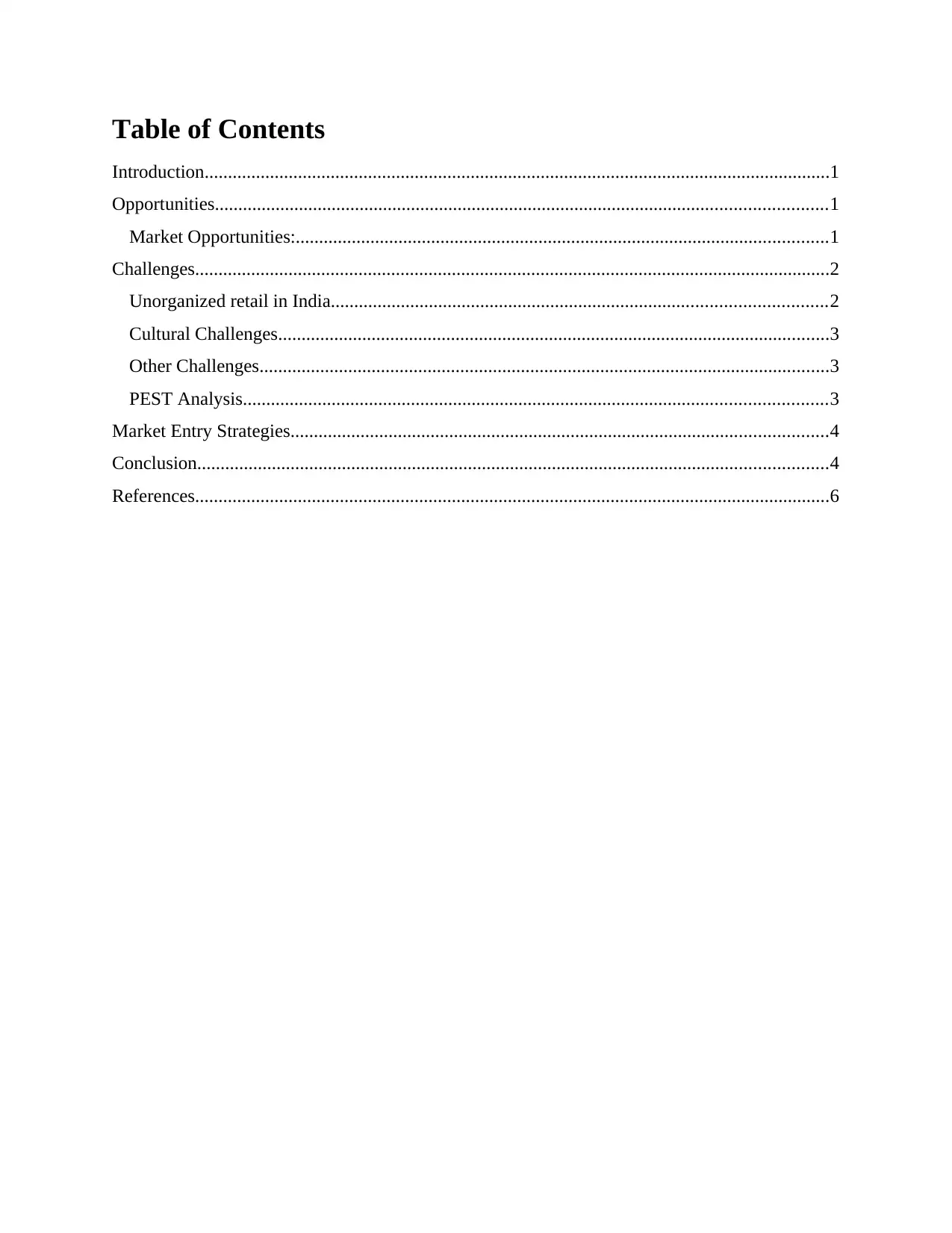
Table of Contents
Introduction......................................................................................................................................1
Opportunities...................................................................................................................................1
Market Opportunities:..................................................................................................................1
Challenges........................................................................................................................................2
Unorganized retail in India..........................................................................................................2
Cultural Challenges......................................................................................................................3
Other Challenges..........................................................................................................................3
PEST Analysis.............................................................................................................................3
Market Entry Strategies...................................................................................................................4
Conclusion.......................................................................................................................................4
References........................................................................................................................................6
Introduction......................................................................................................................................1
Opportunities...................................................................................................................................1
Market Opportunities:..................................................................................................................1
Challenges........................................................................................................................................2
Unorganized retail in India..........................................................................................................2
Cultural Challenges......................................................................................................................3
Other Challenges..........................................................................................................................3
PEST Analysis.............................................................................................................................3
Market Entry Strategies...................................................................................................................4
Conclusion.......................................................................................................................................4
References........................................................................................................................................6
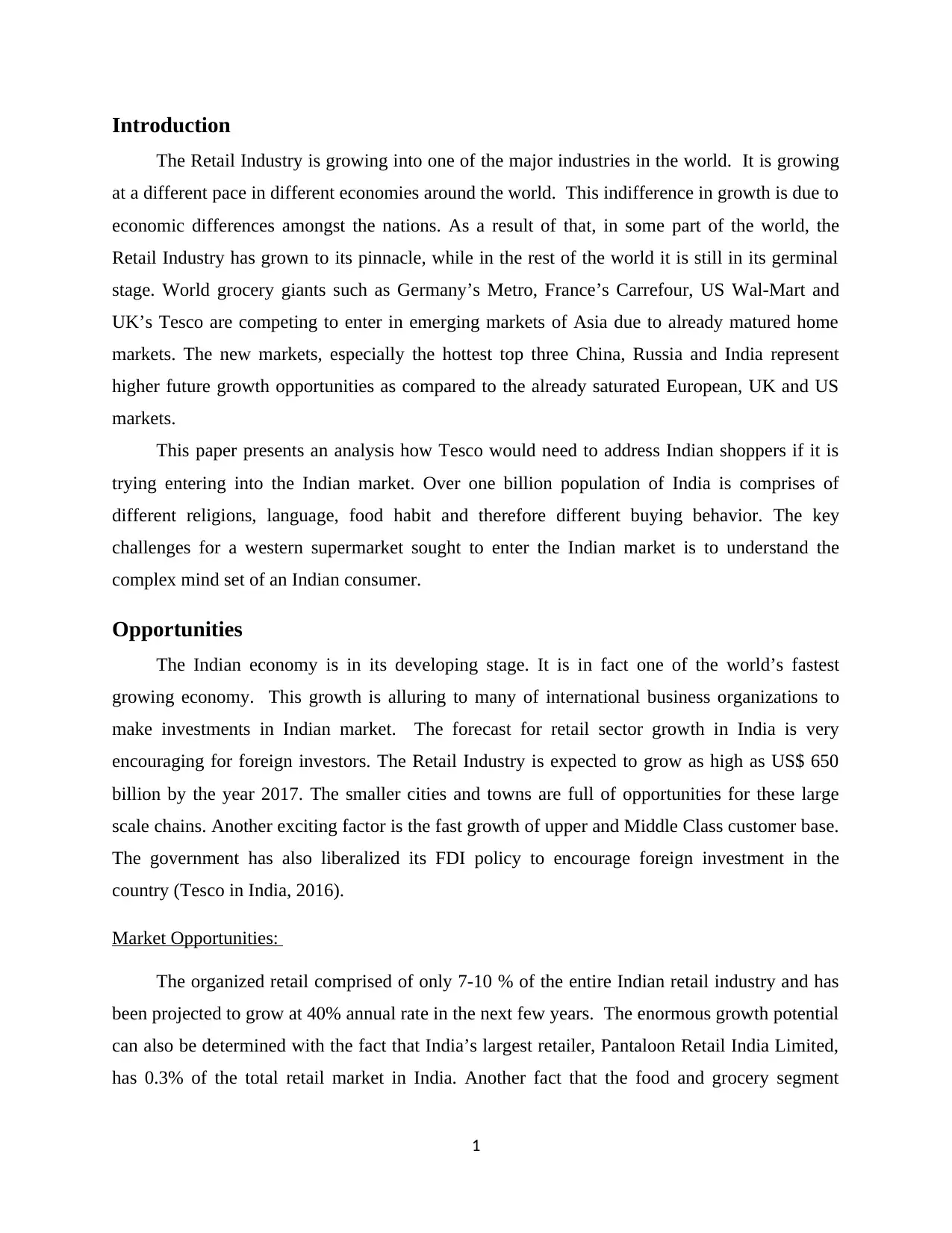
Introduction
The Retail Industry is growing into one of the major industries in the world. It is growing
at a different pace in different economies around the world. This indifference in growth is due to
economic differences amongst the nations. As a result of that, in some part of the world, the
Retail Industry has grown to its pinnacle, while in the rest of the world it is still in its germinal
stage. World grocery giants such as Germany’s Metro, France’s Carrefour, US Wal-Mart and
UK’s Tesco are competing to enter in emerging markets of Asia due to already matured home
markets. The new markets, especially the hottest top three China, Russia and India represent
higher future growth opportunities as compared to the already saturated European, UK and US
markets.
This paper presents an analysis how Tesco would need to address Indian shoppers if it is
trying entering into the Indian market. Over one billion population of India is comprises of
different religions, language, food habit and therefore different buying behavior. The key
challenges for a western supermarket sought to enter the Indian market is to understand the
complex mind set of an Indian consumer.
Opportunities
The Indian economy is in its developing stage. It is in fact one of the world’s fastest
growing economy. This growth is alluring to many of international business organizations to
make investments in Indian market. The forecast for retail sector growth in India is very
encouraging for foreign investors. The Retail Industry is expected to grow as high as US$ 650
billion by the year 2017. The smaller cities and towns are full of opportunities for these large
scale chains. Another exciting factor is the fast growth of upper and Middle Class customer base.
The government has also liberalized its FDI policy to encourage foreign investment in the
country (Tesco in India, 2016).
Market Opportunities:
The organized retail comprised of only 7-10 % of the entire Indian retail industry and has
been projected to grow at 40% annual rate in the next few years. The enormous growth potential
can also be determined with the fact that India’s largest retailer, Pantaloon Retail India Limited,
has 0.3% of the total retail market in India. Another fact that the food and grocery segment
1
The Retail Industry is growing into one of the major industries in the world. It is growing
at a different pace in different economies around the world. This indifference in growth is due to
economic differences amongst the nations. As a result of that, in some part of the world, the
Retail Industry has grown to its pinnacle, while in the rest of the world it is still in its germinal
stage. World grocery giants such as Germany’s Metro, France’s Carrefour, US Wal-Mart and
UK’s Tesco are competing to enter in emerging markets of Asia due to already matured home
markets. The new markets, especially the hottest top three China, Russia and India represent
higher future growth opportunities as compared to the already saturated European, UK and US
markets.
This paper presents an analysis how Tesco would need to address Indian shoppers if it is
trying entering into the Indian market. Over one billion population of India is comprises of
different religions, language, food habit and therefore different buying behavior. The key
challenges for a western supermarket sought to enter the Indian market is to understand the
complex mind set of an Indian consumer.
Opportunities
The Indian economy is in its developing stage. It is in fact one of the world’s fastest
growing economy. This growth is alluring to many of international business organizations to
make investments in Indian market. The forecast for retail sector growth in India is very
encouraging for foreign investors. The Retail Industry is expected to grow as high as US$ 650
billion by the year 2017. The smaller cities and towns are full of opportunities for these large
scale chains. Another exciting factor is the fast growth of upper and Middle Class customer base.
The government has also liberalized its FDI policy to encourage foreign investment in the
country (Tesco in India, 2016).
Market Opportunities:
The organized retail comprised of only 7-10 % of the entire Indian retail industry and has
been projected to grow at 40% annual rate in the next few years. The enormous growth potential
can also be determined with the fact that India’s largest retailer, Pantaloon Retail India Limited,
has 0.3% of the total retail market in India. Another fact that the food and grocery segment
1
⊘ This is a preview!⊘
Do you want full access?
Subscribe today to unlock all pages.

Trusted by 1+ million students worldwide
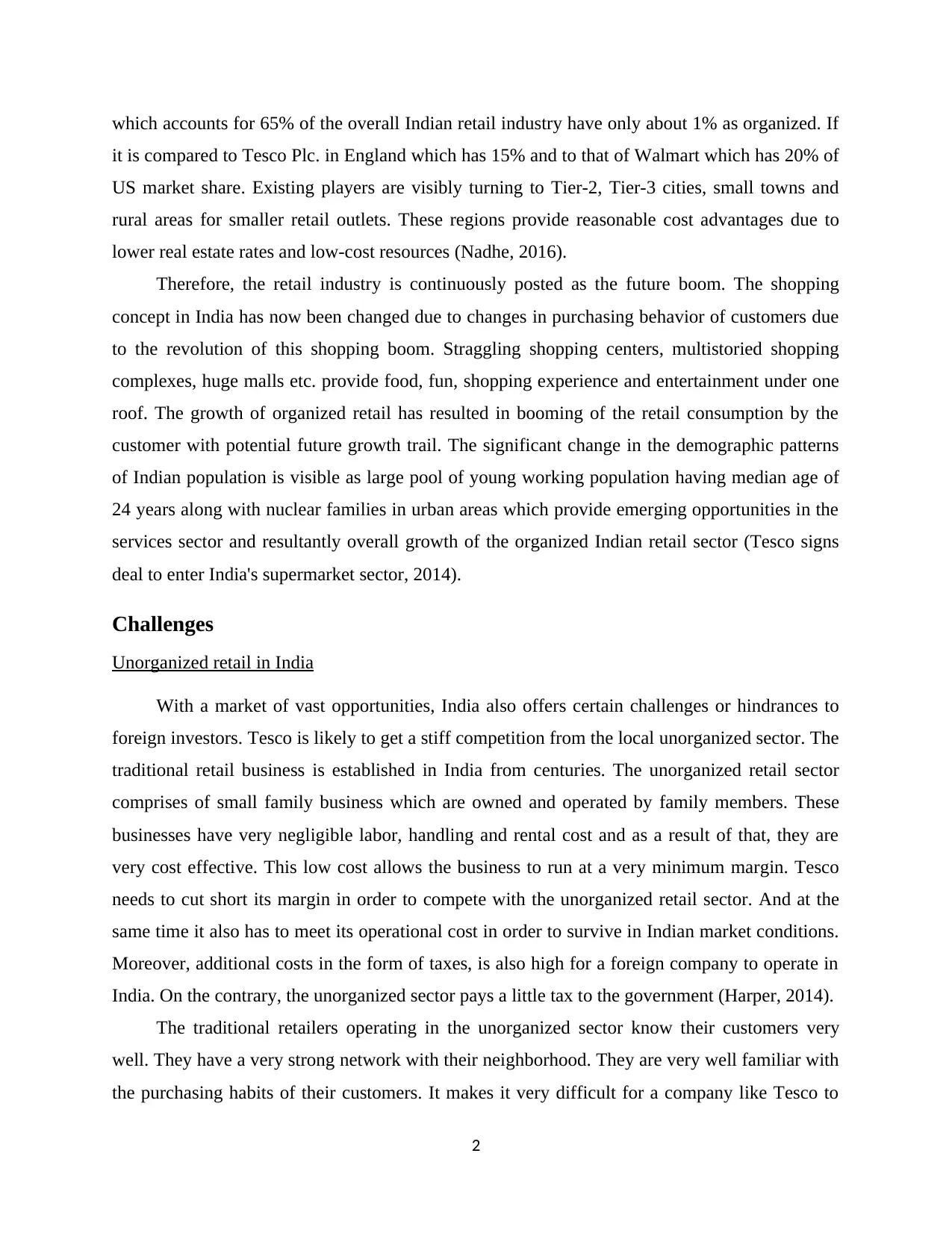
which accounts for 65% of the overall Indian retail industry have only about 1% as organized. If
it is compared to Tesco Plc. in England which has 15% and to that of Walmart which has 20% of
US market share. Existing players are visibly turning to Tier-2, Tier-3 cities, small towns and
rural areas for smaller retail outlets. These regions provide reasonable cost advantages due to
lower real estate rates and low-cost resources (Nadhe, 2016).
Therefore, the retail industry is continuously posted as the future boom. The shopping
concept in India has now been changed due to changes in purchasing behavior of customers due
to the revolution of this shopping boom. Straggling shopping centers, multistoried shopping
complexes, huge malls etc. provide food, fun, shopping experience and entertainment under one
roof. The growth of organized retail has resulted in booming of the retail consumption by the
customer with potential future growth trail. The significant change in the demographic patterns
of Indian population is visible as large pool of young working population having median age of
24 years along with nuclear families in urban areas which provide emerging opportunities in the
services sector and resultantly overall growth of the organized Indian retail sector (Tesco signs
deal to enter India's supermarket sector, 2014).
Challenges
Unorganized retail in India
With a market of vast opportunities, India also offers certain challenges or hindrances to
foreign investors. Tesco is likely to get a stiff competition from the local unorganized sector. The
traditional retail business is established in India from centuries. The unorganized retail sector
comprises of small family business which are owned and operated by family members. These
businesses have very negligible labor, handling and rental cost and as a result of that, they are
very cost effective. This low cost allows the business to run at a very minimum margin. Tesco
needs to cut short its margin in order to compete with the unorganized retail sector. And at the
same time it also has to meet its operational cost in order to survive in Indian market conditions.
Moreover, additional costs in the form of taxes, is also high for a foreign company to operate in
India. On the contrary, the unorganized sector pays a little tax to the government (Harper, 2014).
The traditional retailers operating in the unorganized sector know their customers very
well. They have a very strong network with their neighborhood. They are very well familiar with
the purchasing habits of their customers. It makes it very difficult for a company like Tesco to
2
it is compared to Tesco Plc. in England which has 15% and to that of Walmart which has 20% of
US market share. Existing players are visibly turning to Tier-2, Tier-3 cities, small towns and
rural areas for smaller retail outlets. These regions provide reasonable cost advantages due to
lower real estate rates and low-cost resources (Nadhe, 2016).
Therefore, the retail industry is continuously posted as the future boom. The shopping
concept in India has now been changed due to changes in purchasing behavior of customers due
to the revolution of this shopping boom. Straggling shopping centers, multistoried shopping
complexes, huge malls etc. provide food, fun, shopping experience and entertainment under one
roof. The growth of organized retail has resulted in booming of the retail consumption by the
customer with potential future growth trail. The significant change in the demographic patterns
of Indian population is visible as large pool of young working population having median age of
24 years along with nuclear families in urban areas which provide emerging opportunities in the
services sector and resultantly overall growth of the organized Indian retail sector (Tesco signs
deal to enter India's supermarket sector, 2014).
Challenges
Unorganized retail in India
With a market of vast opportunities, India also offers certain challenges or hindrances to
foreign investors. Tesco is likely to get a stiff competition from the local unorganized sector. The
traditional retail business is established in India from centuries. The unorganized retail sector
comprises of small family business which are owned and operated by family members. These
businesses have very negligible labor, handling and rental cost and as a result of that, they are
very cost effective. This low cost allows the business to run at a very minimum margin. Tesco
needs to cut short its margin in order to compete with the unorganized retail sector. And at the
same time it also has to meet its operational cost in order to survive in Indian market conditions.
Moreover, additional costs in the form of taxes, is also high for a foreign company to operate in
India. On the contrary, the unorganized sector pays a little tax to the government (Harper, 2014).
The traditional retailers operating in the unorganized sector know their customers very
well. They have a very strong network with their neighborhood. They are very well familiar with
the purchasing habits of their customers. It makes it very difficult for a company like Tesco to
2
Paraphrase This Document
Need a fresh take? Get an instant paraphrase of this document with our AI Paraphraser

enter into a market where the customers are anonymous. Small retailers also provide credit
facilities to their customers. This credit is often repaid weekly, fortnightly or monthly, making it
convenient for the local customers to purchase their needs from these retailers. These small
factors are not easily noticeable, but are momentous (Baron, 2008).
Cultural Challenges
The customers in India do not purchase food items in bulk like the customers in the UK.
They purchase food requirements on daily basis. The success of these large scale retail
businesses depends on the purchasing habit of their customers. It is favorable for them, if the
customer purchases a bulk of their requirement in one single time. But due to the purchasing
habits of Indian customers, who tends to purchase frequently, but only as much as they require, it
makes it very difficult for Tesco to operate in Indian market conditions. Small retail shops in the
nearby locality are readily accessible to the customers, making them favorable over the large
retail chains like Tesco.
Other Challenges
In the urban, highly populated areas, it is very difficult to find space to set up a large store.
The available space, if any, is of vary high cost. This cost cuts on their margin by a significant
proportion. To overcome the problem of huge rental cost, if the stores are located in remote
areas, away from residential populations, it becomes difficult for them to attract customers to
their location, as it is more convenient for the customers to reach their local retailers, in their
nearby locality, for their daily groceries requirements. There are other challenges for Tesco in
India such as underdeveloped supply chain and absence of robust IT management in logistics in
India, lack of skilled workforce in retailing management, threat of product obsolescence which
needs due considerations (Narayan, 2013).
PEST Analysis
The strategic audit in form of PEST framework can provide a summary of external factors
that would affect Tesco’s Indian operations and is presented in below table.
PEST Analysis for Tesco plc India
Political factors Government restrictions for foreign companies through FDI
3
facilities to their customers. This credit is often repaid weekly, fortnightly or monthly, making it
convenient for the local customers to purchase their needs from these retailers. These small
factors are not easily noticeable, but are momentous (Baron, 2008).
Cultural Challenges
The customers in India do not purchase food items in bulk like the customers in the UK.
They purchase food requirements on daily basis. The success of these large scale retail
businesses depends on the purchasing habit of their customers. It is favorable for them, if the
customer purchases a bulk of their requirement in one single time. But due to the purchasing
habits of Indian customers, who tends to purchase frequently, but only as much as they require, it
makes it very difficult for Tesco to operate in Indian market conditions. Small retail shops in the
nearby locality are readily accessible to the customers, making them favorable over the large
retail chains like Tesco.
Other Challenges
In the urban, highly populated areas, it is very difficult to find space to set up a large store.
The available space, if any, is of vary high cost. This cost cuts on their margin by a significant
proportion. To overcome the problem of huge rental cost, if the stores are located in remote
areas, away from residential populations, it becomes difficult for them to attract customers to
their location, as it is more convenient for the customers to reach their local retailers, in their
nearby locality, for their daily groceries requirements. There are other challenges for Tesco in
India such as underdeveloped supply chain and absence of robust IT management in logistics in
India, lack of skilled workforce in retailing management, threat of product obsolescence which
needs due considerations (Narayan, 2013).
PEST Analysis
The strategic audit in form of PEST framework can provide a summary of external factors
that would affect Tesco’s Indian operations and is presented in below table.
PEST Analysis for Tesco plc India
Political factors Government restrictions for foreign companies through FDI
3
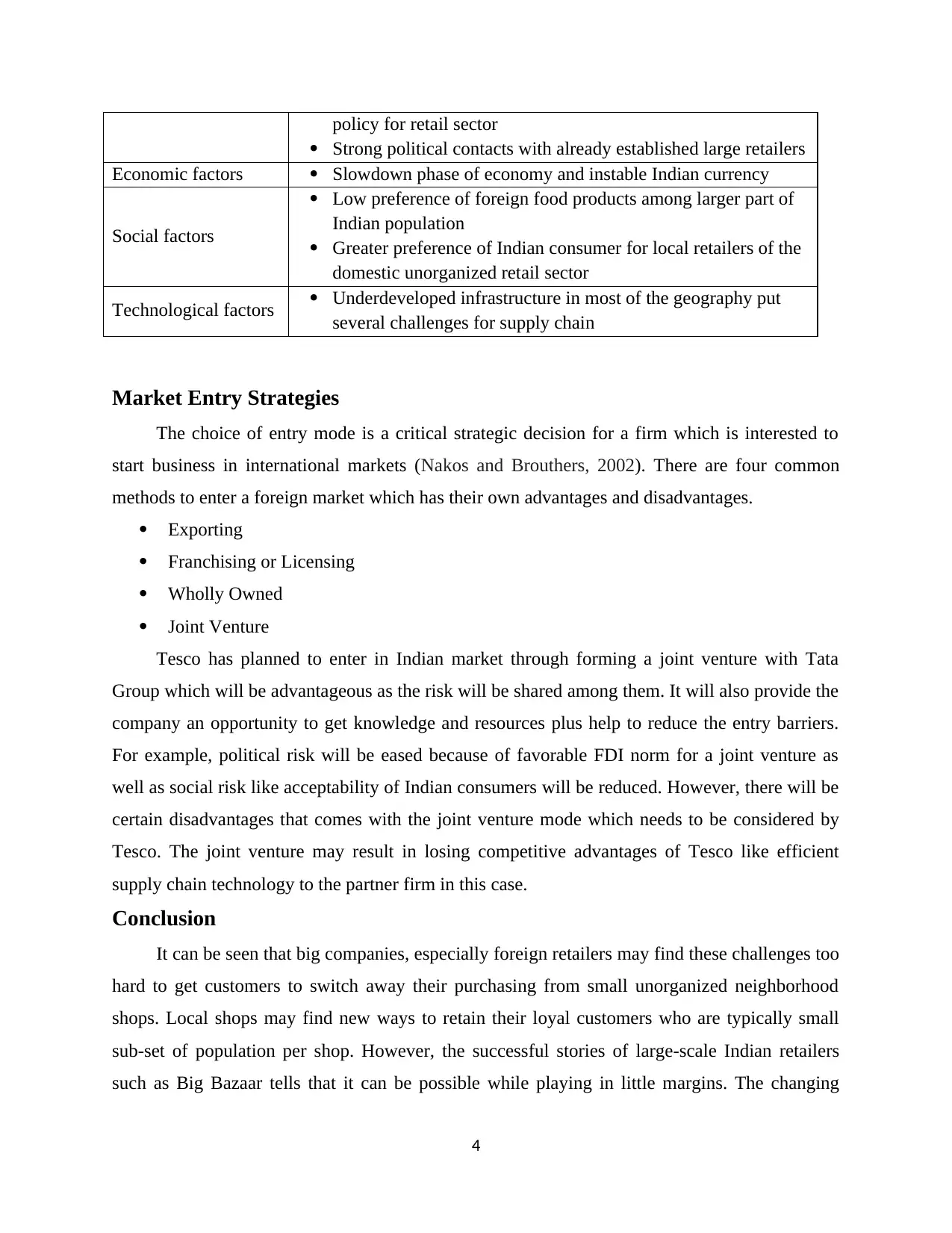
policy for retail sector
Strong political contacts with already established large retailers
Economic factors Slowdown phase of economy and instable Indian currency
Social factors
Low preference of foreign food products among larger part of
Indian population
Greater preference of Indian consumer for local retailers of the
domestic unorganized retail sector
Technological factors Underdeveloped infrastructure in most of the geography put
several challenges for supply chain
Market Entry Strategies
The choice of entry mode is a critical strategic decision for a firm which is interested to
start business in international markets (Nakos and Brouthers, 2002). There are four common
methods to enter a foreign market which has their own advantages and disadvantages.
Exporting
Franchising or Licensing
Wholly Owned
Joint Venture
Tesco has planned to enter in Indian market through forming a joint venture with Tata
Group which will be advantageous as the risk will be shared among them. It will also provide the
company an opportunity to get knowledge and resources plus help to reduce the entry barriers.
For example, political risk will be eased because of favorable FDI norm for a joint venture as
well as social risk like acceptability of Indian consumers will be reduced. However, there will be
certain disadvantages that comes with the joint venture mode which needs to be considered by
Tesco. The joint venture may result in losing competitive advantages of Tesco like efficient
supply chain technology to the partner firm in this case.
Conclusion
It can be seen that big companies, especially foreign retailers may find these challenges too
hard to get customers to switch away their purchasing from small unorganized neighborhood
shops. Local shops may find new ways to retain their loyal customers who are typically small
sub-set of population per shop. However, the successful stories of large-scale Indian retailers
such as Big Bazaar tells that it can be possible while playing in little margins. The changing
4
Strong political contacts with already established large retailers
Economic factors Slowdown phase of economy and instable Indian currency
Social factors
Low preference of foreign food products among larger part of
Indian population
Greater preference of Indian consumer for local retailers of the
domestic unorganized retail sector
Technological factors Underdeveloped infrastructure in most of the geography put
several challenges for supply chain
Market Entry Strategies
The choice of entry mode is a critical strategic decision for a firm which is interested to
start business in international markets (Nakos and Brouthers, 2002). There are four common
methods to enter a foreign market which has their own advantages and disadvantages.
Exporting
Franchising or Licensing
Wholly Owned
Joint Venture
Tesco has planned to enter in Indian market through forming a joint venture with Tata
Group which will be advantageous as the risk will be shared among them. It will also provide the
company an opportunity to get knowledge and resources plus help to reduce the entry barriers.
For example, political risk will be eased because of favorable FDI norm for a joint venture as
well as social risk like acceptability of Indian consumers will be reduced. However, there will be
certain disadvantages that comes with the joint venture mode which needs to be considered by
Tesco. The joint venture may result in losing competitive advantages of Tesco like efficient
supply chain technology to the partner firm in this case.
Conclusion
It can be seen that big companies, especially foreign retailers may find these challenges too
hard to get customers to switch away their purchasing from small unorganized neighborhood
shops. Local shops may find new ways to retain their loyal customers who are typically small
sub-set of population per shop. However, the successful stories of large-scale Indian retailers
such as Big Bazaar tells that it can be possible while playing in little margins. The changing
4
⊘ This is a preview!⊘
Do you want full access?
Subscribe today to unlock all pages.

Trusted by 1+ million students worldwide
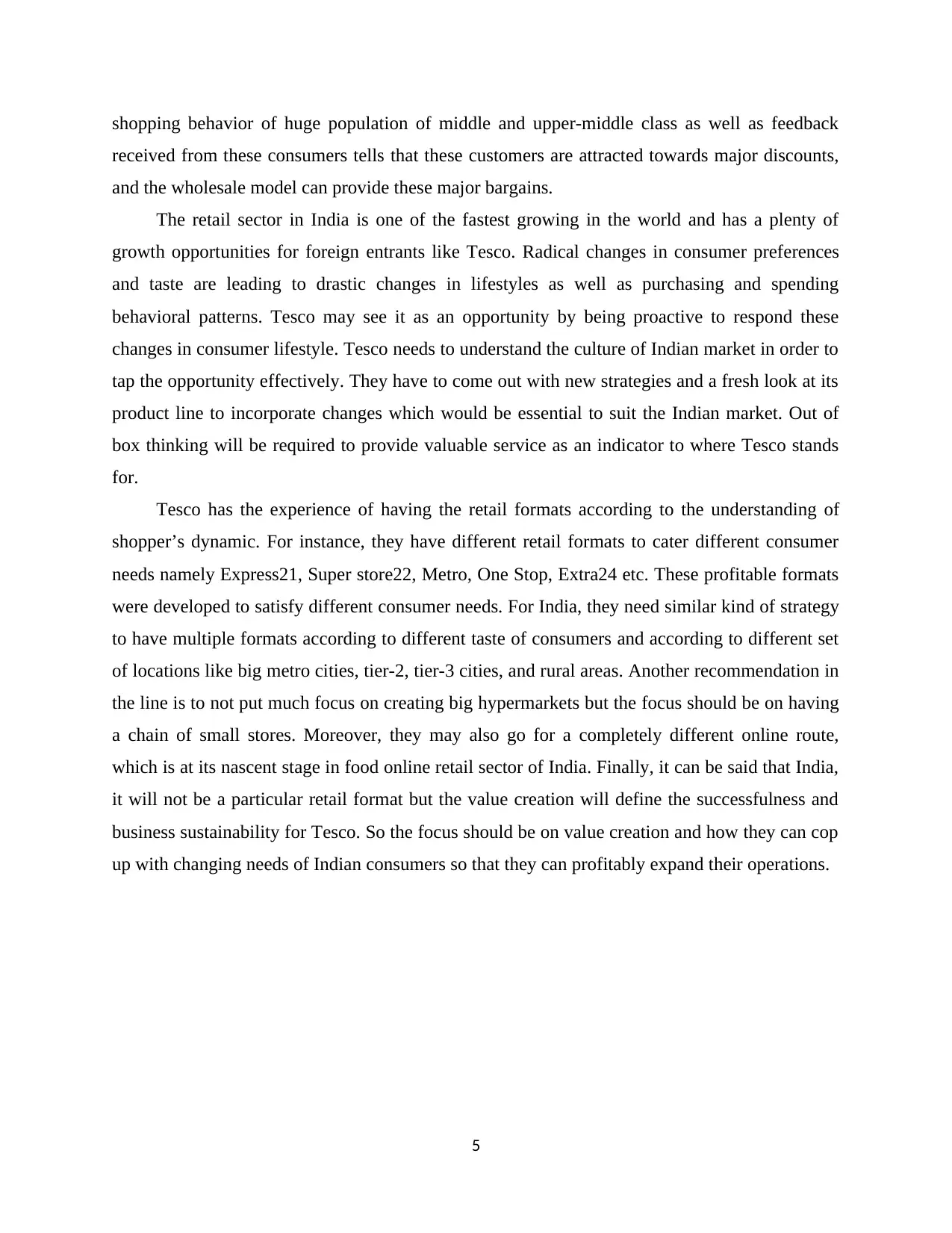
shopping behavior of huge population of middle and upper-middle class as well as feedback
received from these consumers tells that these customers are attracted towards major discounts,
and the wholesale model can provide these major bargains.
The retail sector in India is one of the fastest growing in the world and has a plenty of
growth opportunities for foreign entrants like Tesco. Radical changes in consumer preferences
and taste are leading to drastic changes in lifestyles as well as purchasing and spending
behavioral patterns. Tesco may see it as an opportunity by being proactive to respond these
changes in consumer lifestyle. Tesco needs to understand the culture of Indian market in order to
tap the opportunity effectively. They have to come out with new strategies and a fresh look at its
product line to incorporate changes which would be essential to suit the Indian market. Out of
box thinking will be required to provide valuable service as an indicator to where Tesco stands
for.
Tesco has the experience of having the retail formats according to the understanding of
shopper’s dynamic. For instance, they have different retail formats to cater different consumer
needs namely Express21, Super store22, Metro, One Stop, Extra24 etc. These profitable formats
were developed to satisfy different consumer needs. For India, they need similar kind of strategy
to have multiple formats according to different taste of consumers and according to different set
of locations like big metro cities, tier-2, tier-3 cities, and rural areas. Another recommendation in
the line is to not put much focus on creating big hypermarkets but the focus should be on having
a chain of small stores. Moreover, they may also go for a completely different online route,
which is at its nascent stage in food online retail sector of India. Finally, it can be said that India,
it will not be a particular retail format but the value creation will define the successfulness and
business sustainability for Tesco. So the focus should be on value creation and how they can cop
up with changing needs of Indian consumers so that they can profitably expand their operations.
5
received from these consumers tells that these customers are attracted towards major discounts,
and the wholesale model can provide these major bargains.
The retail sector in India is one of the fastest growing in the world and has a plenty of
growth opportunities for foreign entrants like Tesco. Radical changes in consumer preferences
and taste are leading to drastic changes in lifestyles as well as purchasing and spending
behavioral patterns. Tesco may see it as an opportunity by being proactive to respond these
changes in consumer lifestyle. Tesco needs to understand the culture of Indian market in order to
tap the opportunity effectively. They have to come out with new strategies and a fresh look at its
product line to incorporate changes which would be essential to suit the Indian market. Out of
box thinking will be required to provide valuable service as an indicator to where Tesco stands
for.
Tesco has the experience of having the retail formats according to the understanding of
shopper’s dynamic. For instance, they have different retail formats to cater different consumer
needs namely Express21, Super store22, Metro, One Stop, Extra24 etc. These profitable formats
were developed to satisfy different consumer needs. For India, they need similar kind of strategy
to have multiple formats according to different taste of consumers and according to different set
of locations like big metro cities, tier-2, tier-3 cities, and rural areas. Another recommendation in
the line is to not put much focus on creating big hypermarkets but the focus should be on having
a chain of small stores. Moreover, they may also go for a completely different online route,
which is at its nascent stage in food online retail sector of India. Finally, it can be said that India,
it will not be a particular retail format but the value creation will define the successfulness and
business sustainability for Tesco. So the focus should be on value creation and how they can cop
up with changing needs of Indian consumers so that they can profitably expand their operations.
5
Paraphrase This Document
Need a fresh take? Get an instant paraphrase of this document with our AI Paraphraser
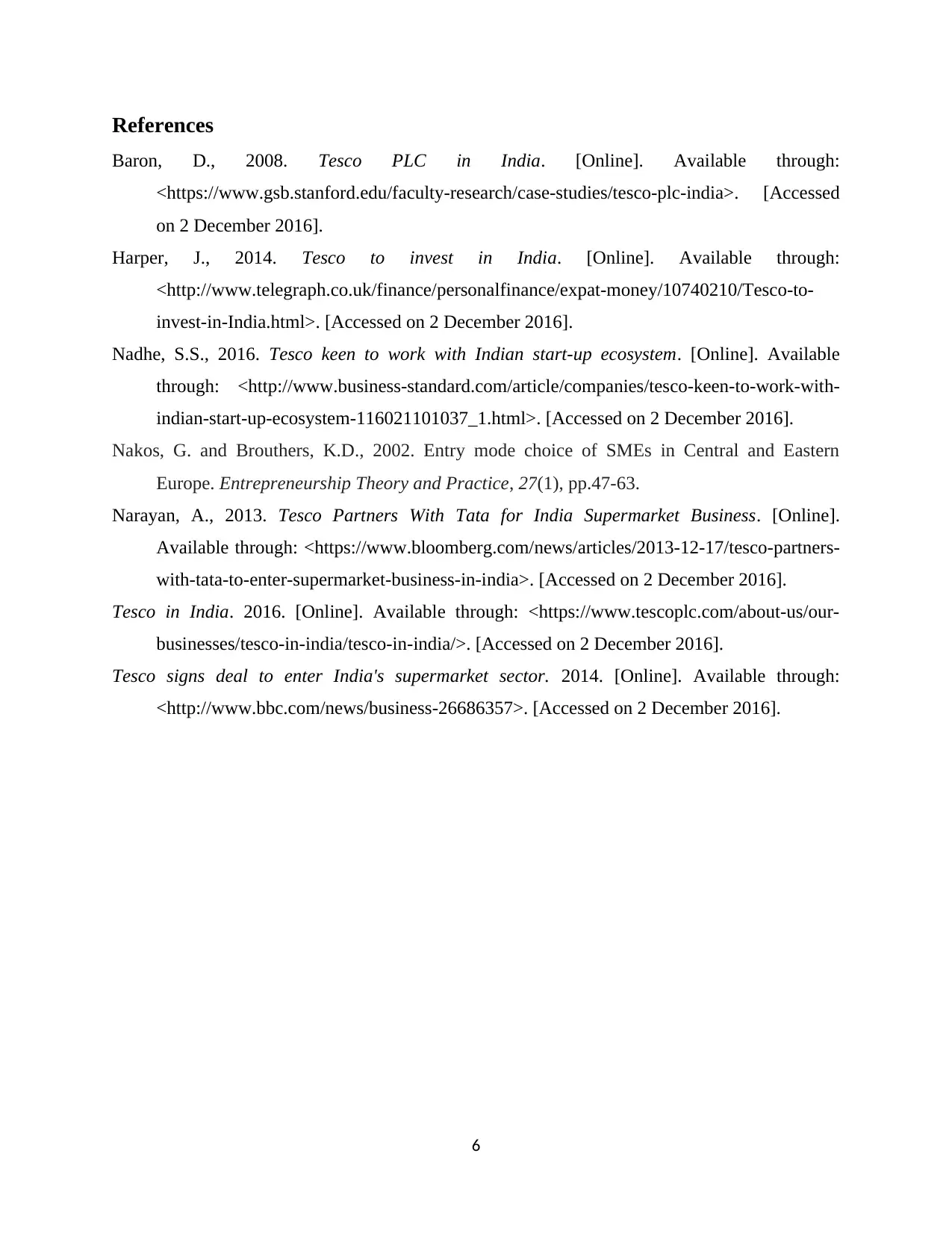
References
Baron, D., 2008. Tesco PLC in India. [Online]. Available through:
<https://www.gsb.stanford.edu/faculty-research/case-studies/tesco-plc-india>. [Accessed
on 2 December 2016].
Harper, J., 2014. Tesco to invest in India. [Online]. Available through:
<http://www.telegraph.co.uk/finance/personalfinance/expat-money/10740210/Tesco-to-
invest-in-India.html>. [Accessed on 2 December 2016].
Nadhe, S.S., 2016. Tesco keen to work with Indian start-up ecosystem. [Online]. Available
through: <http://www.business-standard.com/article/companies/tesco-keen-to-work-with-
indian-start-up-ecosystem-116021101037_1.html>. [Accessed on 2 December 2016].
Nakos, G. and Brouthers, K.D., 2002. Entry mode choice of SMEs in Central and Eastern
Europe. Entrepreneurship Theory and Practice, 27(1), pp.47-63.
Narayan, A., 2013. Tesco Partners With Tata for India Supermarket Business. [Online].
Available through: <https://www.bloomberg.com/news/articles/2013-12-17/tesco-partners-
with-tata-to-enter-supermarket-business-in-india>. [Accessed on 2 December 2016].
Tesco in India. 2016. [Online]. Available through: <https://www.tescoplc.com/about-us/our-
businesses/tesco-in-india/tesco-in-india/>. [Accessed on 2 December 2016].
Tesco signs deal to enter India's supermarket sector. 2014. [Online]. Available through:
<http://www.bbc.com/news/business-26686357>. [Accessed on 2 December 2016].
6
Baron, D., 2008. Tesco PLC in India. [Online]. Available through:
<https://www.gsb.stanford.edu/faculty-research/case-studies/tesco-plc-india>. [Accessed
on 2 December 2016].
Harper, J., 2014. Tesco to invest in India. [Online]. Available through:
<http://www.telegraph.co.uk/finance/personalfinance/expat-money/10740210/Tesco-to-
invest-in-India.html>. [Accessed on 2 December 2016].
Nadhe, S.S., 2016. Tesco keen to work with Indian start-up ecosystem. [Online]. Available
through: <http://www.business-standard.com/article/companies/tesco-keen-to-work-with-
indian-start-up-ecosystem-116021101037_1.html>. [Accessed on 2 December 2016].
Nakos, G. and Brouthers, K.D., 2002. Entry mode choice of SMEs in Central and Eastern
Europe. Entrepreneurship Theory and Practice, 27(1), pp.47-63.
Narayan, A., 2013. Tesco Partners With Tata for India Supermarket Business. [Online].
Available through: <https://www.bloomberg.com/news/articles/2013-12-17/tesco-partners-
with-tata-to-enter-supermarket-business-in-india>. [Accessed on 2 December 2016].
Tesco in India. 2016. [Online]. Available through: <https://www.tescoplc.com/about-us/our-
businesses/tesco-in-india/tesco-in-india/>. [Accessed on 2 December 2016].
Tesco signs deal to enter India's supermarket sector. 2014. [Online]. Available through:
<http://www.bbc.com/news/business-26686357>. [Accessed on 2 December 2016].
6
1 out of 8
Related Documents
Your All-in-One AI-Powered Toolkit for Academic Success.
+13062052269
info@desklib.com
Available 24*7 on WhatsApp / Email
![[object Object]](/_next/static/media/star-bottom.7253800d.svg)
Unlock your academic potential
Copyright © 2020–2025 A2Z Services. All Rights Reserved. Developed and managed by ZUCOL.





